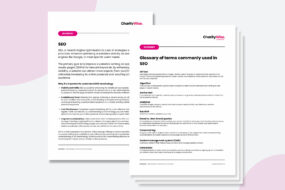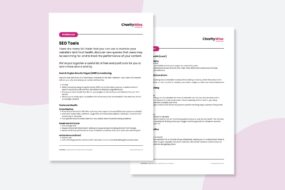

Google Trends is now over 15 years old, but many charities still aren’t getting the most out of it as a marketing tool.
This guide will help to explain some of Google Trend’s key concepts, as well as tips on how to use the tool effectively.
What is Google Trends?
Google Trends is a useful free marketing tool that can be used to identify current trending topics and seasonal trends in different locations.
It shows the relative popularity of topics that people are searching for in Google but doesn’t give you an indication of the search volume. The relative popularity of the term is shown in comparison with all searches for that area and date range.
- Google Trends makes a selection of popular search terms. Highly specific queries with low volume are given a 0 rating, everything else is scaled on a 1-100 scale, depending on its popularity in relation to all other searches
- Google’s sampling will include data that may have been removed from other search products (such as related searches or autocomplete). Google says it tries to filter out attempts to manipulate or spam the interface, but mentions this might still appear if it becomes popular enough
- The data includes real-time information as well as historic data for previous years. This enables you to examine topical trends as well as recurring seasonal ones, or examine the popularity of a topic over time
In a nutshell, Trends will not provide information on every search made; the scope is too vast for that. It can, however, provide a mine of information that is relevant to your charity and users’ habits. In summary, a few of things you can use Google Trends to:
- Find seasonal trends for topical searches that overlap your charity’s remit
- Discover topical search trends that reflect society’s concerns (e.g. ‘food crisis’, ‘gender identity’)
- See the topical popularity and impact of offline advertising, such as TV or social media campaigns
- Discover related topics that are searched in connection with issues (indicating supporting or dissenting points of view)
- Check on the relative popularity and awareness of your brand compared to others in your voluntary sector
Keyword or entity?
When you start to enter a term you wish to search for, Google will make some suggestions. At the top of the list will be the selected terms as a general search query. It will also suggest entities that it has noticed in connection with the keywords. This helps you isolate specific and relevant queries from ambiguous terms that might actually mean something else.
For example, ‘apple’ might refer to a fruit crop or a tech company. If you are a farmer, the former is obviously going to be more relevant.
Top tip:
Pick a relevant topic entity wherever possible, as the data is generally more reliable. If you are comparing different topics (up to 5 at once) then make sure you compare the same entities (or search terms).
Entities can cover a number of things, and will continue to expand as Google does a better job of understanding content on the web. They can include topic-related items (things that share the same concept), specific brands or things that match the query, or even actions. For example:

- “Assisted living” can be used as a search term, but Google has also noted this as a ‘topic’ which will likely be more relevant if I am looking for trends about making properties more accessible
- Google has also seen a company that it associates with the topic, and there is also a sitcom that uses the target term in its title. Note that if I were to just use the search term, associated keywords for the business and the sitcom would be considered in the results
You’ll notice that if you compare the same term using different topics, you’ll get different results (and an alert from Google):

If you wish to narrow the focus of a keyword search, you can use the following operators:
| Search term | Type of results you can see |
|---|---|
| tennis shoes | Results can include searches containing both tennis and shoes in any order. Results can also include searches like "red tennis shoes," "funny shoes for tennis," or "tennis without shoes." No misspellings, spelling variations, synonyms, plural, or singular versions of your terms are included. |
| "tennis shoes" | Results include the exact phrase inside double quotation marks, possibly with words before or after, like "red tennis shoes." |
| tennis + squash | Results can include searches containing the words "tennis" OR "squash." |
| tennis -shoes | Results include searches containing the word "tennis," but exclude searches with the word "shoes." |
| center + centre + centere | Results include alternative spellings like “centre” or “centere,” and common misspellings like "centere." Trends considers each version of a word a different search, including misspellings. |
You can then, in one of Google’s clunkier interfaces, add in additional terms and topics to compare, or edit and remove an existing search term:

Here we can see that over the last 5 years, popularity for ‘Winter fuel payments’ spikes every year around November . . . with the exception of a spike in May 2022 when there was an announcement about new Government funds available.
‘Consumer price index’ is an increasingly popular topic and ‘fuel poverty’ although a relatively niche topic is just starting to increase in popularity at the same time of ‘winter fuel payments’.
Using filters
If all this wasn’t fun enough, Trends also offers filtering options so you can further refine the data:

You can quickly change the filter type on a query to switch the date range or country. There are also options underneath the search terms you can take advantage of:
Date range
This allows you to change the period in which the term is examined. You can examine long-term trends to see if terms or topics related to your charity are gaining or losing popularity, or even real-time data in the last few hours, to surface hyper-topical interest such as the time of day a query is most popular.
For example, the term ‘XL Bully’ was relatively unsearched until recent news events catapulted it into public awareness:
- Checking the date range allows you to check if a topic has regular and predictable surges of popularity. It’s also a good way to potentially track the ‘halo’ impact of awareness marketing (such as an ad campaign or news story)
- Regular surges of popularity for queries can indicate content gaps where creating useful material might appeal to interested users. Be careful, however, of creating content for ‘spikes’ – topics that surge then die off completely. It’s likely that interest in that term will have passed before the content is ready and indexed on the web
- You can use the custom time range option to set a specific date and time range if you need
Categories
This lets you specify a topical category. If your chosen term has multiple meanings, you can help isolate the correct context which will make the analysis more accurate. Note that this might help refine results where this isn’t automatically suggested by Google when you enter your key terms.
- This can be particularly useful for brand terms when there is potential ambiguity with non-brand queries, or similar brand names in different sectors
- This can also highlight topics of popularity within certain topic sectors. During lockdown, ‘online meetings’ didn’t change popularity much, but changing the category filter to ‘health’ showed a different result:

Looking into this further showed an increase for online meeting of therapy groups and counselling sessions, which could not be held face-to-face at that time.
Search results
This allows you to refine the type of search results to compare popularity. By default, this is set to ‘web search’ which will cover everything, but you can also specify particular types of Google search products too: images, news, shopping and YouTube video searches.
It is worth checking the popularity of topics that have relevant search result platforms. If you sell products, then the Google Shopping filter might alert you to surges in popularity of certain items or brands. With the increase in video consumption, seeing YouTube trends is also useful if this is a channel on which you create content:

Data comparison
Clicking the ‘change filter’ option on the topic queries allows you to compare data from different regions or against a global average. Comparing different date ranges is not recommended as this is heavily skewed by topical events.
Other features
The main feature set relies on users knowing what questions to ask (search terms, topics, etc). However, Trends also has a section which will show related topics, which may surface subjects that were not immediately obvious with the first query.
The coronavirus pandemic caused rapid, wholesale changes to the information people need answers to. People asked more questions and sought help to navigate changes to lifestyles and routines. Searches about places and local events plummeted during lockdown, before regaining popularity are restrictions were lifted.
If you are looking for trend data over time, this might help put context behind any trend dips and peaks around local search.
 Top tips
Top tips
Some general techniques to get useful data from Google Trends.
Think about people first, and keywords second
While Trends is a useful place to check those high volume keywords, the most useful insights come from thinking about the people you are trying to reach. Focusing first on what people are trying to achieve in search engines can lead you to realisations and ideas in completely unexpected areas. Looking at things from a user’s perspective – their daily routines, the challenges and problems they face – could unlock entirely new ideas and understanding about how you can help them and prove useful. This could include:
- Contacting regional branches
- Assistance and grants for specific problems
- Volunteering in the area, or around specific events or campaigns (e.g. Red Nose Day)
Brand awareness
Enter your charity’s name to check that popularity is not waning, or being confused with non-relevant ambiguous searches (this is something that third party keyword monitoring tools may not be able to differentiate).
Brand searches tend to locate pages from the brand domain, so are ‘easy click’ traffic.
Appearing as a recognised ‘business’ or ‘organisation’ topic shows the Google is aware of the name and likely to return it for searches it thinks are relevant.
Declining brand popularity may reflect a loss of engagement and interest, or increased activity from competitors in search marketing.
Know your seasonality
Very few, if any, searches maintain an upward trend over time. Look at products, services and even core pages to determine if there are regular peaks in interest, then coincide marketing to arrive before or during that peak. Think about refreshing core content in time for seasonal peaks of interest such as fundraising for large events such as the London Marathon, etc.
Changing the date range can analyse micro-trends . . . for example, looking at the days in the lead-up to an event may show people looking for registration places, organisations looking for volunteers, free or replacement spots for participating.
Emergent and related topics
Top and rising terms and subjects can be great areas to highlight content that users want to read. This can be dealt with on core pages or a blog/news post if this is a peripheral or ephemeral topic.
Some consideration must be given to what is already appearing in search results for these queries. For rising search topics, there may not be a great deal of depth in search results (providing an opportunity). Otherwise, an enterprising site may have already been identified as an authority source on the subject by offering a good content page that has quality and expertise.
Don’t neglect ‘breakout’ topics: although Google may not have an established volume for these terms (and remember, 15% of queries it sees every day are new) they represent a good opportunity to get ahead of a trend and start occupying the search space for a relevant topic.
Check keyword seed lists
There are lots of keyword tools that generate scores of keyword suggestions based on these appearing…at some time…on a related search in Google. Most will be sorted based on estimated volume, which for non-paid interfaces relies on highly abstracted figures provided by Google (or for some tools, their in-house benchmark).
Running these through Google Trends and filtering by category or region, can help illustrate seasonal periods of interest for terms that may not have initially been considered, and further trigger avenues of content creation using the related ‘rising’ and ‘top’ terms.
Compare and contrast
It’s tempting to take the first view at face-value, but this can often be misleading. Instead, check different views of the same topic to ensure you’ve got the right context and understanding.
For example, a 7-day view of a topic may look incredibly popular, but taken over a longer period, show a downward trend or the characteristic ‘blip’ of a fad. It’s worth playing around with filters to find out what is a universally popular trend, and what simply shows popularity in certain channels, areas or dates.
Context
Trends is hugely sensitive to events in the world (news content especially). Use the ‘news’ filter in Google Search to find the context around sudden spikes in popularity. This can inform further strategies about timing content and statements for known or expected events (such as legislative changes).
Summary
Google Trends is an interesting tool that has its own method of determining data, which is generally vague to people outside Google. It is, however, one of the few tools that can analyse search intent from a historic perspective (Google uses its data to create its ‘Year in Search’ roundups) to an almost real-time level, where you can see the impact of a national advertising campaign or the ‘halo’ effect of awareness on a topic.
Trend topics are heavily driven by current events and social media influence. If these are important channels that affect your audience and supporters, then Trends can allow you to navigate the shifts and topics that emerge in discourse on the web.




